TM 55-2840-231-23
1-33. Dismantling Engine Into Major Functional Assemblies.
a.
During dismantling, examine all major functional assemblies for serviceability. The condition of an
assembly can often be better determined by examination during dismantling. Signs of scoring, burning, and
excessive wear or the presence of metal particles are danger signals. Thorough inspection should be made
immediately. Look for any indications of work incorrectly performed during previous maintenance or over-
haul. Report any such indications to the local maintenance officer.
b.
Care must be exercised to prevent the entrance of dirt and other foreign material into the engine.
Whenever practical, temporary covers should- be used to seal all openings in the dismantled engine. All
threads, splines, and pilot diameters should be protected against damage. Protective covers should be of a
shape that prohibits assembly with mating parts without removing the covers.
c.
Unless parts of a particular engine are to be held for a special inspection, discard all gaskets, lock-
washers, preformed packings, O-rings, diaphragms, and cotter pins as they are removed. These parts must
not be mixed with new parts of similar type and must not be used again. Arrangement of self-locking nuts
shall be determined in accordance with minimum prevailing torque at reassembly. Self-locking nuts
shall be tested for reuse in accordance with TM 55-1500-204-25/1.
Prolonged contact with lubricating oil (item 5,
Appendix D) may cause a skin rash. Those areas
of skin and clothing that come in contact with
lubricating oil should be thoroughly washed
immediately. Enclosed areas where lubricating
oil is used should be adequately ventilated to keep
mist and fumes to a minimum.
Lubricating oil may soften paint upon contact. If
lubricating oil is spilled on painted surfaces, these
surfaces should be thoroughly washed.
d.
Remove the magnetic drain plug from the bottom of the gearbox and allow oil to drain before the
engine is rotated in the turnover stand.
1-34. Preservation Maintenance. Preservation
tion and replacement of the dehydrating agent.
fied shipping container as long as possible.
maintenance is not represervation,
Allow engine awaiting installation
but is the regular inspec-
to remain in the dehumidi-
1-40

